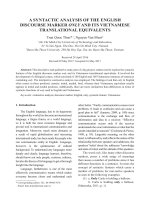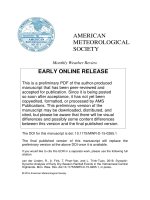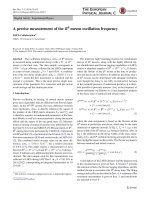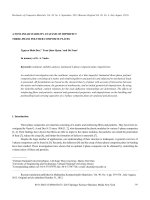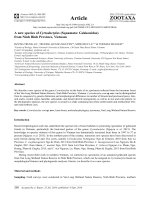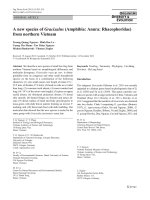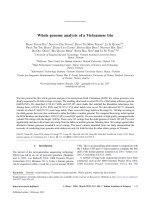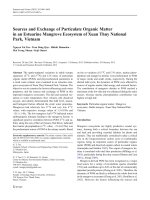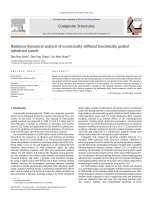DSpace at VNU: A cross-system analysis of sedimentary organic carbon in the mangrove ecosystems of Xuan Thuy National Park, Vietnam
Bạn đang xem bản rút gọn của tài liệu. Xem và tải ngay bản đầy đủ của tài liệu tại đây (1.4 MB, 8 trang )
Journal of Sea Research 67 (2012) 69–76
Contents lists available at SciVerse ScienceDirect
Journal of Sea Research
journal homepage: www.elsevier.com/locate/seares
A cross-system analysis of sedimentary organic carbon in the mangrove ecosystems
of Xuan Thuy National Park, Vietnam
Nguyen Tai Tue a, b,⁎, Nguyen Thi Ngoc c, Tran Dang Quy d, Hideki Hamaoka b,
Mai Trong Nhuan d, Koji Omori b
a
Graduate School of Science and Engineering, Ehime University, 2-5 Bunkyo-cho, Matsuyama, Japan
Center for Marine Environmental Studies, Ehime University, 2-5 Bunkyo-cho, Matsuyama, Japan
Graduate School of Science and Technology, Kumamoto University, Kumamoto 860-8555, Japan
d
Faculty of Geology, Hanoi University of Science, 334 Nguyen Trai, Thanh Xuan, Hanoi, Viet nam
b
c
a r t i c l e
i n f o
Article history:
Received 19 June 2011
Received in revised form 16 October 2011
Accepted 20 October 2011
Available online 12 November 2011
Keywords:
Mangrove ecosystems
Sediment
Organic carbon
C/N
δ13C
Xuan Thuy National Park
a b s t r a c t
A cross-system analysis of bulk sediment composition, total organic carbon (TOC), atomic C/N ratio, and carbon
isotope composition (δ13C) in 82 surface sediment samples from natural and planted mangrove forests, bank and
bottom of tidal creeks, tidal flat, and the subtidal habitat was conducted to examine the roles of mangroves in
sedimentation and organic carbon (OC) accumulation processes, and to characterize sources of sedimentary
OC of the mangrove ecosystem of Xuan Thuy National Park, Vietnam. Sediment grain sizes varied widely from
5.4 to 170.2 μm (mean 71.5 μm), with the fine sediment grain size fraction (b 63 μm) ranging from 11 to 99.3%
(mean 72.5%). Bulk sediment composition suggested that mangroves play an important role in trapping
fine sediments from river outflows and tidal water by the mechanisms of tidal current attenuation by vegetation and the ability of fine roots to bind sediments. The TOC content ranged from 0.08 to 2.18% (mean
0.78%), and was higher within mangrove forests compared to those of banks and bottoms of tidal creeks,
tidal flat, and subtidal sediments. The sedimentary δ13C ranged from −27.7 to −20.4‰ (mean −24.1‰),
and mirrored the trend observed in TOC variation. The TOC and δ13C relationship showed that the factors of microbial remineralization and OC sources controlled the TOC pool of mangrove sediments. The comparison of δ13C
and C/N ratio of sedimentary OC with those of mangrove and marine phytoplankton sources indicated that the
sedimentary OC within mangrove forests and the subtidal habitat was mainly composed of mangrove and marine phytoplankton sources, respectively. The application of a simple mixing model showed that the mangrove
contribution to sedimentary OC decreased as follows: natural mangrove forest> planted mangrove forest> tidal
flat> creek bank> creek bottom > subtidal habitat.
© 2011 Elsevier B.V. All rights reserved.
1. Introduction
Mangrove forests occur along ocean coastlines throughout the tropics
and subtropics, and they support numerous ecosystem services such as
nursery grounds for commercial and ecologically important fish, shrimp
and shellfish, nesting and foraging habitat of migratory birds, and as a renewable resource of fuel (Alongi, 2011). The total net primary production of mangrove ecosystems has been estimated at 218±72 Tg C/year
(Bouillon et al., 2008; Twilley et al., 1992), ranking as one of the most
productive biomes on earth. As result, the mangrove ecosystem is an important sink (Eong, 1993; Twilley et al., 1992) and source (Mfilinge et al.,
2005; Rodelli et al., 1984) of organic carbon (OC). In term of the OC sink,
Donato et al. (2011) showed that whole-ecosystem carbon storage of the
⁎ Corresponding author at: 790-8577 Center for Marine Environmental Studies,
Ehime University, 2-5 Bunkyo-cho, Matsuyama, Japan. Tel.: + 81 89 927 9643, + 81
902 894 1610 (mobile); fax: + 81 89 927 9643.
E-mail addresses: , (N.T. Tue).
1385-1101/$ – see front matter © 2011 Elsevier B.V. All rights reserved.
doi:10.1016/j.seares.2011.10.006
Indo-Pacific mangrove forests consists of tree and detrital organic matter,
and sedimentary OC containing on average 1023 Mg C/ha. As a result
mangroves are among the most carbon-rich forests in the tropics.
Therefore, mangrove OC is an important factor in the global and local
OC budgets (Duarte et al., 2005). However, mangrove ecosystems are
ecologically diverse and their carbon storage in sediments can vary widely between ecosystems, from under 2 to b40%, with the global median
value at 2.2% (Kristensen et al., 2008). The global carbon budget extrapolations are consequently biased (Bouillon et al., 2008). Therefore, the
level and dynamics of OC storage in sediments of individual mangrove
ecosystem are needed to better assess the global carbon budget. This is
particularly so in mangrove ecosystems of Vietnam where little data
have been published (i.e., Tue et al., 2011a,b).
The storage of OC in mangrove sediments is dependent on several
factors such as the sources of OC (Bouillon et al., 2003) and the presence
of mangroves (Donato et al., 2011). Sedimentary OC can originate
from local production by mangroves and/or tidally suspended organic
matter (Bouillon et al., 2003; Kristensen, et al., 2008). Therefore, the
70
N.T. Tue et al. / Journal of Sea Research 67 (2012) 69–76
contribution of each OC source is needed to assess the mangrove contribution. Additionally, the presence of mangroves will increase the sedimentation rates, and consequently OC burial in sediments (Perry and
Berkeley, 2009). Thus, it is necessary to understand the driving forces
behind the OC accumulation in the mangrove ecosystem.
Mangrove ecosystems comprise of habitats, including intertidal
mangroves, tidal creeks, creek banks, tidal flat, and subtidal zone. The
sedimentary OC pools in these habitats may be distinguished by differences in their respective OC sources (Tue et al., 2011a) and by tidal amplitude (Bouillon et al., 2003). Therefore, a cross-system analysis of
sedimentary OC is needed to understand the biogeochemical cycling of
OC through the whole mangrove ecosystem. Furthermore, the amount
and sources of sedimentary OC in these habitats should be determined
for mangrove and coastal food web studies (Bouillon et al., 2002) and
paleoenvironmental reconstruction (Tue et al., 2011a).
In present study we examine the hypothesis of whether mangroves
boost the sedimentation and OC accumulation processes in an estuarine
mangrove ecosystem. We investigate a cross-system analysis of bulk
sediment composition, TOC, C/N ratio, and δ13C in 82 surface sediment
samples from natural and planted mangrove forests, bank and bottom
of tidal creeks, tidal flat, and subtidal habitat for (1) examining the
roles of mangroves in sedimentation and OC accumulation processes,
and (2) characterizing the sources of sedimentary OC in the mangrove
ecosystem.
2. Materials and methods
2.1. Study area
The present work was conducted in an estuarine mangrove ecosystem of Xuan Thuy National Park (XTP) in northern Vietnam (Fig. 1). The
XTP is located along the southern part of the Ba Lat Estuary of the Red
River which is the largest river in northern Vietnam. The XTP covers a
total wetland area of 12,000 ha, of which about 3000 ha are covered
by mangrove forests. Generally, mangroves in the XTP can be classified
into natural and planted mangrove forests. The natural mangrove forests are mainly distributed in the northern area of the XTP, dominated by the mangrove species Sonneratia caseolaris, Kandelia obovata,
Aegiceras corniculatum, and Avicennia marina. The planted mangrove
forests are mainly distributed in the southern part of the XTP, dominated
by K. obovata (Hong et al., 2004). The mangrove ecosystems of the XTP
are a valuable ecological and economic resource, providing essential
nursery grounds for many species of fishes, invertebrates, and waterfowl.
The mangrove ecosystems are therefore a major stopover for migratory
birds between northern and southern Asia (Thuy, 2004). Additionally,
the mangroves also provide renewable fuel, and directly support the livelihood for local communities. The XTP is recognized as a hotspot of biodiversity in Vietnam, and as a result the Convention on Wetlands of
International Importance declared XTP as the first Ramsar Site of Southeast Asia ().
2.2. Field sampling
Field work was conducted from 10 to 25 June, 2010 in the XTP. A
total of 82 surface sediment samples were collected across a broad
range of mangrove habitats, comprising natural and planted mangrove forests, creek bank, creek bottom, tidal flat, and subtidal habitat. The respective numbers of sediment samples of each the
habitats were 12, 20, 5, 5, 13, and 27, and their locations are shown
in Fig. 1. These samples represented all major habitat types of the
mangrove ecosystem in the XTP, and as such well reflected the OC
sources, hydrodynamic conditions, as well as marine-mangrove
Fig. 1. Map of Xuan Thuy National Park, and the sampling sites. The cross-system sampling sites are assigned as M: natural mangroves; P: planted mangroves; CB: creek bank;
C: creek bottom; T: tidal flat; and S: subtidal habitat. The digit number assigns the order number of sediment samples in each habitat.
N.T. Tue et al. / Journal of Sea Research 67 (2012) 69–76
interactions. Surface sediments (0–2 cm) were collected by a stainless steel spade during low tide. Sediment samples were packed in labeled polyethylene bags for further analysis. Samples were
immediately stored in iceboxes and transported to the laboratory
where they were frozen at −20 °C until analysis.
2.3. Sample preparation and analysis
2.3.1. Sediment grain size analysis
Sediments were firstly dried in an electric oven at 105 °C for 48 h.
Sediment grain sizes were analyzed by sieve and pipette methods
that are used for sand-rich and mud-rich samples, respectively. For
the sieve method, a total of 20 g of dried sand-rich sediment was
wet-sieved using a mesh size of 0.063 mm to get rid of mud from
the sediments. Particles coarser than 0.063 mm were collected and
dried in an electric oven at 105 °C for 24 h, and then were gently
pounded with fingers. The particles were passed through a series of
sieves with mesh sizes of 0.50, 0.25, 0.125 and 0.063 mm by a sieve
shaker (AS 200 Retsch, Germany). The particles retained on each
sieve were weighed and converted into a percentage of the total sediment sample.
For pipette analysis, the fine particles passing through the
0.063 mm mesh were poured into a liter glass cylinder. Distilled
water was then added to bring it up exactly to 1000 ml. The water
column was vigorously stirred by a glass rod until all of the material
was uniformly suspended throughout the water column. Once completed, a pipette was inserted to a depth of 20 cm and exactly 25 ml
of water was withdrawn at time intervals of 40 s, 16 min, 59 min,
and 15 h. The suspension samples were expelled into weighed
50 ml beakers, and then the water completely evaporated from the
beakers using an electric oven at 105 °C. The dried beakers and particles were re-weighed, and the particle weights were determined by
subtracting the beakers from the dried beakers and particles. The
weights of these fractions were converted into a percentage of the
total sediment sample. These fractions corresponded to mesh sizes
of 0.01, 0.005, 0.001, and b0.001 mm.
2.3.2. Stable isotope and C/N analysis
For δ 13C, TOC, and C/N ratio analysis, sediment samples were first
completely dried in an electric oven at 60 °C, and then ground to a
fine powder by an agate mortar and pestle. A total of 200 mg of pulverized sediment sample was then placed in a microtube and approximately 6 ml of 1 N HCl was added and repeated two times, mixed
thoroughly using a vibrating mixer, and then left at room temperature for 24 h to remove carbonates. After acid treatment, the samples
were thoroughly rinsed with milli-Q filtered distilled-deionized
water and dried in an electric oven at 60 °C for 48 h.
Stable isotope δ 13C, TOC, and total nitrogen (TN) values were measured by using a stable isotope mass spectrometer (ANCA-SL, PDZ Europa, Ltd.) at the Center for Marine Environmental Studies, Ehime
University, Japan. δ 13C was expressed in ‰ (permil) deviations from
the standard value by the following Eq. (1):
13
δ Cð‰Þ ¼ ð
Rsample
À1Þ × 1000
Rstandard
ð1Þ
where R = 13C/ 12C, Rsample is the isotope ratio of the sample, and
Rstandard is the isotope ratio of a standard referenced to Pee Dee
Belemnite (PDB) limestone carbonate. The analytical error was± 0.1‰
for δ 13C.
71
seagrasses, and other tidal organic matters. Variations in the proportional contributions of these organic matter sources can cause a
change in the sedimentary δ 13C values. To determine the relative contribution of each organic matter source to sedimentary OC pool, a
simple mixing model has been successfully used in mangrove ecosystems (i.e., Tue et al., 2011a), estuarine environments (i.e., He et al.,
2010; Yu et al., 2010), and marine environments (i.e., Meksumpun
et al., 2005). The simple mixing model can be written as below:
13
13
13
13
13
δ Csed ¼ f MG × δ CMG þf MaA × δ CMaA þf MiA × δ CMiA þf S × δ CS
þf P × δ13 CP þ…þf n × δ13 Cn f MG þf MaA þf MiA þf S þf P þf n ¼ 100%
ð2Þ
where fMG, fMaA, fMiA, fS, fP, and fn are the relative contribution of mangrove tissues, macroalgae, microalgae, seagrasses, marine phytoplankton, and n source (%), respectively; δ 13Csed, δ 13CMG, δ 13CMaA,
δ 13CMiA, δ 13CS, δ 13CP, and δ 13Cn are the carbon stable isotope values
of sedimentary OC, mangrove tissues, macroalgae, microalgae, seagrasses, marine phytoplankton, and n sources, respectively.
The Ba Lat Estuary is a highly turbid estuary (van Maren, 2007),
and as a result the local presence of aquatic macrophytes, seagrasses,
and macroalgae is very low to absent (Tue et al., 2011a,b). In addition,
the production of benthic microalgae within mangrove forests is usually very low, not only due to light limitation but also to inhibition by
soluble tannins (Bouillon et al., 2000; Robertson and Alongi, 1992).
When there are only two sources (e.g., mangrove litters and marine
phytoplankton), substitution of fP= 100% - fMG in Eq. (2), we have:
f MG ð%Þ ¼
δ13 Csed Àδ13 CP
× 100
δ13 CMG Àδ13 CP
ð3Þ
3. Results
3.1. Bulk sediment composition
Sediments in the present study were composed of fine sand, silt,
and clay. The fractions of these compositions decreased from silt,
through clay, and to fine sand. Plotting the percentages of these compositions on a ternary diagram shows that the main sediment facies
can be classified into clayed silt, silt, sandy silt, silty sand, and fine
sand (Fig. 2A). The silt composition was predominant, ranging from
11 to 90%. The silt fraction was greater than 60% in sediments of mangrove forests, banks and bottoms of creeks, but markedly dropped to
less than 40% in subtidal sediments (Fig. 2B). The clay fraction varied
similarity to the variation pattern of silt (Fig. 2B), with high fractions
in sediments of mangrove forests, and the bank and bottom of creeks,
whereas it was very low in subtidal sediments. The sand fraction ranged from 0.7 to 89%, and displayed an inverse trend to that of silt and
clay. The sand fraction was very high in subtidal sediments, and decreased to less than 20% in sediments of mangrove forests, and in
the banks and bottoms of creeks (Fig. 2B).
Sediment grain sizes varied widely from 5.4 to 170.2 μm, with a
mean of 71.5 μm. On average, the fine sediment grain size fraction
(b63 μm, mean ± SD) decreased as follows: planted mangroves,
creek bank, creek bottom, natural mangroves, tidal flat, and the subtidal habitat, with respective values of 93.7 ± 7.7, 95.4 ± 5.5, 92.6 ±
4.8, 88.7 ± 14.3, 81.8 ± 19, and 37.3 ± 34.7% (Figs. 3A and 4A).
2.4. Fractional contribution of organic carbon sources
3.2. Total organic carbon (TOC) content, C/N ratios, and carbon isotope
composition (δ 13C)
The OC sources to mangrove sediments can originate from both
autochthonous production such as mangroves, macroalgae and
microalgae, and allochthonous sources such as phytoplankton,
The TOC content (% dry weight) of sediments from natural and
planted mangrove forests, creek bank, creek bottom, tidal flat, and
the subtidal habitat are shown in Figs. 3B and 4B. Overall, the TOC
72
N.T. Tue et al. / Journal of Sea Research 67 (2012) 69–76
Fig. 2. The bulk sediment composition in mangrove ecosystems of the XTP (A) sediment facies; (B) sediment compositions.
content ranged from 0.08 to 2.18%, with a mean of 0.78%. The TOC
content (mean ± 1 SD) showed a considerable decrease from 1.45 ±
0.45% (n = 12) to 1.09 ± 0.32% (n = 20) between natural and planted
mangrove sediments, respectively. The TOC content showed a decreasing trend from vegetated sediments, through creek bank, to
creek bottom sediments. The TOC contents were 0.81 ± 0.53%
(n = 5) and 0.37 ± 0.29% (n = 5) for bank and bottom of creek
sediments, respectively. Toward the sea, the TOC content slightly increased to 0.86 ± 0.27% (n = 13) in sediments of tidal flat, but it was
markedly lower at 0.24 ± 0.21% (n = 20) in sediments of subtidal
habitat (Figs. 3B, 4B).
The relationship between TOC and the fine sediment grain size fraction (≤63 μm) is shown in Fig. 5 (Spearman correlation coefficient=
−0.64, p b 0.0001), which was best described by a non-linear least-
Fig. 3. Spatial distributions of fine sediment grain size fractions (%) (A); TOC (%) (B); C/N ratio (mol/mol) (C); and δ13C (‰) (D) in the surface sediments of the XTP.
N.T. Tue et al. / Journal of Sea Research 67 (2012) 69–76
73
Fig. 4. The variations of fine sediment grain size fractions (%) (A); TOC (%) (B); C/N ratio (mol/mol) (C); and δ13C (‰) (D) in various habitats as shown in Fig. 1.
squares regression model. The model showed TOC content increasing
progressively as the fine sediment fraction increased in the range of
0–60%, then TOC content increased much faster in the range of the
fine sediment fraction from 60 to 85%. The TOC content then reached
a plateau from 85 to 100%, indicating that the OC was readily absorbed
into the fine sediment grain sizes.
There was a significant positive correlation between TOC and TN
(TN = 0.09*TOC + 0.007, R 2 = 0.89, p b 0.01, Fig. 6), suggesting the
same origin of TOC and TN. The regression line of TOC and TN passed
very close to the origin (0,0), suggesting that the inorganic nitrogen
content was insignificant and the most of the nitrogen content measured by the method of this study was related to organic nitrogen.
In present study, the TN can be used instead of organic nitrogen to
calculate the atomic C/N ratio and ascertain the origins of sedimentary OC (Andrews et al., 1998; Tue et al., 2011a).
The atomic C/N ratio ranged from 4.5 to 19.5, with a mean of 11.0.
The C/N ratio trend was unclear with variation in TOC content
(Figs. 3C, 4C). The C/N ratios (mean ± 1 SD) slightly increased from
11.6 ± 2.5 (n = 12) to 12.3 ± 3.1 (n = 20) between natural and
planted mangrove forests. From vegetated sediments to creek bottoms, the C/N ratios slightly decreased from 11.2 ± 2.0 (n = 5) in
creek bank to 10.4 ± 1.3 (n = 5) in creek bottom sediments. The C/N
Fig. 5. Non-linear regression of the TOC (%) and fine sediment grain size fraction (%) in
surface sediments of the XTP.
ratios slightly increased to 12.8 ± 3.3 (n = 13) in tidal flat sediments,
however, this markedly dropped off to the lowest values of 8.8 ± 2.9
(n = 27) in subtidal sediments. The lowest C/N ratios were generally
associated with sediments poor in OC, which were mainly composed
of the coarser grained sediments (Figs. 3A,C).
The sedimentary δ 13C values ranged from − 27.7 to − 20.4‰, with
an average of − 24.1‰. In general, the sedimentary δ 13C values
showed an inverse relationship with TOC content (Figs. 3D, 4D). The
sedimentary δ 13C values (mean ± 1 SD) increased from −25.9 ± 1.4
(n = 12) to −24.6 ± 1.1‰ (n = 20) between natural and planted
mangroves. From vegetated sediments to creek bottoms, the δ13C
values slightly increased to −24.1 ± 1.3‰ (n= 5) in creek bank sediments, and to −24.0 ±0.9‰ (n=5) in creek bottom sediments. Toward
the sea, the δ13C values slightly decreased to −24.2 ± 1.0‰ (n= 13) in
tidal flat sediments, then markedly increased to −22.8 ± 1.0‰ (n= 27)
in subtidal sediments. The more decrease in δ13C values were associated
with sediments rich in OC of vegetated mangroves, and more enriched
δ13C values in the low OC content in the subtidal sediments.
The cross-system analysis of TOC and δ 13C showed an inverse relationship and was described by a non-linear least-squares regression
model (Spearman correlation coefficient = −0.91, p b 0.0001, Fig. 7).
Fig. 6. Linear regression of the TOC (%) and TN (%) for the surface sediments of the XTP,
the regression line runs very close to the origin (0,0), suggesting the N-inorganic is
very small compared with the TN, and TN can therefore be used instead of organic nitrogen for determining the sources of sedimentary OC.
74
N.T. Tue et al. / Journal of Sea Research 67 (2012) 69–76
Fig. 7. The inverse relationship between TOC (%) and δ13C (‰) in the surface sediments
of the XTP. The core sediment data were reported by Tue et al. (2011a).
The TOC and δ 13C relationship indicated that the δ 13C values was relatively higher when TOC content was b0.5%. The TOC content (b0.5%)
consisted of sediments from the subtidal habitat and creek bottom.
The δ 13C values decreased much faster (nearly 5‰) in the range of
TOC content from 0.5–2.0%. As seen, belonging to this range the sediments were mainly from tidal flat, creek bank, planted mangrove,
and natural mangrove habitats. When the TOC content was >2%,
the δ 13C values reached to valley of the least-squares line and
approached to those of the local mangrove tissues (− 28.06 ± 1.4‰,
Tue et al., unpublished data), and sediments were only from natural
mangrove forest.
4. Discussion
4.1. Mangroves enhanced the fine sediment grained sizes accumulation
Mangrove forests play an important role in sedimentation processes of coastal environments (Robertson and Alongi, 1992), which
are controlled by both biotic (e.g., tree densities, pneumatophore,
prop and fine root systems), and abiotic factors (e.g., hydrodynamic
processes, sediment supplied sources, sediment particle sizes, and
geomorphological characteristics).
Our results from bulk sediment composition were similar to the
observations by Van Santen et al. (2007) from the XTP mangrove ecosystem. Additionally, this finding is consistent with the mangrove
sediment characteristics from the Gulf of Papue (Walsh and
Nittrouer, 2004), where mangrove sediments consist of clayed silts
>30% and the sand fraction generally b10%. The higher fractions of
clay and silt in the mangrove sediments of our study compared to
those of the tidal flat and subtidal sediments indicated that fine
grained sediments were transported further up into the mangrove
forest zone. Van Santen et al. (2007) reported that within the dense
mangrove forests of the XTP the water levels were as high as 0.9 m,
and 0.2 m during spring and neap tides, respectively. Thus, the tidal
inundation play as a pump preferentially transporting suspended
sediments from the coastal waters to mangrove forests. In addition,
Van Santen et al. (2007) also reported that tidal currents decreased
from bare flats, to through the pioneer vegetation, and to dense mangrove trees. Because the settling velocity of suspended sediments increases with increasing grain sizes (Sternberg et al., 1999), the
reduction of tidal currents is one of multiple mechanisms for the dispersal and accumulation of fine sediments in mangrove forests
(Furukawa and Wolanski, 1996).
In addition to the decreasing current velocity, the friction by vegetation such as tree and aerial root densities, and the ability of fine roots in
binding sediments which can be mainly attributed to the hydrodynamic
attenuation, consequently causes the settling of fine suspended particles (Furukawa et al., 1997). The dense mangrove trees of K. obovata,
A. corniculatum, S. caseolaris, and A. marina in the XTP can effectively
reduce tidal flows and capture silts and clays. Due to the vegetated friction the flow through the mangroves forms the turbulence zones, including jets, eddies, and stagnation zones (Furukawa and Wolanski,
1996; Furukawa et al., 1997). The high level of turbulence maintains
in suspension the flocs of fine cohesive sediments, subsequently, the
fine sediments can be transported further in the mangrove forests,
and become accumulated at the time of high slack tide, as flow currents
approach zero (Furukawa and Wolanski, 1996; Furukawa et al., 1997).
This pattern indicated that the mangroves appear to have an important
physical effect in actively trapping the fine sediments.
Furthermore, Alongi (2009) showed that most sediment imported
into mangrove forests occurs during the wet season, which is a period
when riverine sediment inflow is at its highest. In the mangrove forests of XTP, sedimentation rates in the rainy season are higher than
from the dry season (Van Santen et al., 2007), which is due to the
high sediment loads from the Red River in the rainy season. The median grain sizes of suspended sediments from the Red River varied
from 4 to 8 μm (van Maren, 2007). The fine sediment grain sizes within the mangrove forests from this study were within the range to
those of riverine-suspended sediments, which strongly suggest that
the mangrove forests receive a large fraction of fine grained sediments from the adjoining Red River.
4.2. Cross-system analysis of total organic carbon
In this study, the cross-system analysis of TOC indicated much
lower values than those in the surface sediments (0–1 cm) of mangrove forest from Gazi Bay (Kenya) and Pambala (Sri Lanka) but
close to those found in sediments of mangrove forest from Tana
Estuary (Kenya) (Bouillon and Boschker, 2006). In addition, TOC content showed a decreasing trend from vegetated mangroves, through
to creek systems, and to the subtidal habitat. There are several possible reasons for this trend, including the fine grained sediments,
sources of OC, and microbial remineralization.
The TOC content and fine sediment grain sizes relationship
showed that sediment grain sizes directly influenced the TOC content
(Fig. 5). The sediments with >85% fine grain sizes contained higher
TOC content, referring that finer sediments may provide more reactive surface area that can gather organic matter. In addition, surface
area association can protect OC from remineralization and thus may
provide a control on OC preservation in sediments (Bergamaschi
et al., 1997).
The inverse relationship between TOC and δ 13C is similar to those
reported in sediment core of this mangrove ecosystem (Tue et al.,
2011a) and other OC rich sediments of mangrove forests from
Chunnambar and Pichavaram (India), Pambala (Sri Lanka), Gazi Bay
and Tana delta (Kenya) (Bouillon and Boschker, 2006). These studies
showed that the shift in δ 13C values in relation to TOC content can be
explained by the mechanisms of microbial remineralization and variable inputs of OC sources.
During the microbial remineralization processes, Kristensen et al.
(2008) reviewed that eumycotes (fungi) and oomycotes (prototista)
are highly-adapted for the capture of cellulose-rich vascular plant litter by pervasion and digestion from within organic matter. The rapid
growth of bacteria and fungi on mangrove organic matter will cause
an increase in δ 13C values. In addition, the easy degradation of 13C-depleted organic compounds (i.e., polysaccharide and other phenolic
polymers) of mangrove leaves during decomposing processes will
also increase in δ 13C values in sedimentary OC (Benner et al., 1987,
1990).
Furthermore, the TOC and δ 13C relationship could result from the
admixture of mangrove litters and allochthonous sources, which can
be described by a simple two source mixing model (Bouillon and
Boschker, 2006; Bouillon et al., 2003; Middelburg et al., 1997). As
seen in Fig. 7, the sediments from mangrove forests mainly characterized by δ 13C b −26‰, and TOC content >1%. Particularly, the core and
N.T. Tue et al. / Journal of Sea Research 67 (2012) 69–76
surface sediments from natural mangrove forests had TOC content
>2% and the δ 13C values approached those of mangrove tissues
(−28.06 ± 1.4‰, Tue et al., unpublished data). The most likely explanation for the higher TOC content and more depleted in δ 13C of core
sediments than those of surface sediments of this natural mangrove
forest could be the contribution of below-ground biomass (mangrove
root systems) rather than the from litterfall and tidal deposition. This
observation helps support the hypothesis that the natural mangrove
forests are important in the OC sequestration in sediments, and consequently the sedimentary δ 13C values approached those of mangrove tissues. In contrast, the δ 13C values were quite variable (from
−24 to −20‰) and approached those of marine phytoplankton
(−21.18 ± 0.45‰, Tue et al., unpublished data) in the subtidal sediments (with TOC content b0.5%). This result showed that marine phytoplankton is a dominant OC source in subtidal sediments. Therefore, the
major factor controlling the δ13C and TOC relationship was the OC mass
balance of sources from mangrove litters and marine phytoplankton.
The decrease in TOC content meant concomitant increase in δ13C values
from mangrove forests, through to bank and bottom of creeks, and to the
subtidal habitat. Overall, the mangrove OC mainly accumulated in the
mangrove forest sediments, whereas, subtidal, creek bottom, and creek
bank sediments received relatively more marine phytoplankton source.
4.3. Sources of organic carbon in sediments
In the XTP, mangroves are indicative of C3 plant photosynthesis,
with mangrove leaves expressing a mean δ 13C value of − 28.06 ±
1.4‰, whereas marine phytoplankton has a mean δ 13C value of
−21.18 ± 0.45‰ (Tue et al., unpublished data). In addition, due to
their high cellulose content, mangrove tissues have a mean C/N
ratio of 27.1 ± 10.4, whereas marine phytoplankton, which tends to
be more nitrogen-rich, has relatively low C/N ratios, with a mean of
9.8 ± 1.2 (Tue et al., unpublished data). Therefore, comparison of
δ 13C and C/N ratios of sedimentary OC with those of two OC sources
(mangroves and marine phytoplankton) makes it possible to identify
the sources of sedimentary OC.
As seen in Fig. 8, the bi-plot of C/N ratio and δ 13C shows that sedimentary OC originated from marine phytoplankton and mangrove
sources. The highest δ 13C values and lowest C/N ratios were observed
in sedimentary OC from the subtidal habitat. The sedimentary δ 13C
values and C/N ratios were very similar to those of marine phytoplankton, indicating that the marine phytoplankton supplied a significant OC contribution to subtidal sediments. However, higher C/N
ratios were also observed in some coarser subtidal sediment samples.
This pattern can be explained by the low TN absorption capacities of
coarser sediment grain sizes (Bergamaschi et al., 1997). The gradual
Fig. 8. Comparison of C/N ratios (mol/mol) and δ13C values in the surface sediments
from various habitats to those of OC sources. Open and filled diamonds and error
bars denote means and standard deviation for the marine phytoplankton (n = 3) and
mangrove leaves (n = 26) sources, respectively (Tue et al., unpublished data).
75
increase in C/N ratios, consistent with a progressive decrease in δ 13C
values of sediments from the subtidal habitat to bottoms and banks
of creeks (Figs. 4C, D and 8), suggests a decrease in the contribution
of marine phytoplankton to these sediments. From bottoms to
banks of creeks, a gradual increase in the C/N ratios and a concomitant decrease in δ 13C values indicated that sedimentary OC decreased
in the marine phytoplankton constituent and increased in mangrove
OC. The tidal flat sedimentary OC slightly elevated the C/N ratio and
decreased in δ 13C compared to those of the creek banks, suggesting
that sedimentary OC consisted more of mangrove-derived material.
In the planted mangrove forest, the δ 13C values decreased from seaward and creek edges (often with low mangrove tree densities) to
the center of the mangrove forest (often dense mangrove trees)
(Fig. 3D), indicating that marine phytoplankton was the predominant
in sediments from seaward and the creek edge of mangrove forests. In
natural mangrove forest, the δ 13C values approached the carbon isotope composition of mangrove tissues, thus, the C/N ratios were
also expected to increase to that of mangrove leaves (27.1 ± 10.4,
Tue et al., unpublished data). However, sedimentary C/N ratios were
low relative to mangrove tissues, suggesting that there were rich nitrogen inputs (Middelburg et al., 1996). The mechanisms controlling
nitrogen in sedimentary OC consist of below-ground input of
nitrogen-rich mangrove material, nitrogen fixing-bacteria, uptake of
available dissolved nitrogen compounds by benthic bacteria, and the
import nitrogen rich materials (Middelburg et al., 1996; Muzuka
and Shunula, 2006).
From previous discussion and the references therein, Eq. (3) was
applied to calculate the relative contribution of mangrove litters to
the sedimentary OC of the mangrove ecosystem from the XTP. A spatial distribution map of mangrove contribution has been generated
showing the general contribution by mangroves decreased as follows:
natural mangrove forest > planted mangrove forest > tidal flat > creek
bank > creek bottom > subtidal habitat (Fig. 9A and B). The spatial distribution map also showed that the natural mangrove forest and the
densely planted mangrove forest (i.e., at the sampling sites P13, P14,
P16, P18, P19) contributed more than 80% of the OC in their sediments
(Fig. 9B). In addition, the mangrove contribution increased slightly with
distance from seaward and creek edges (i.e., P7 b P6b P5 b M7). This pattern showed that the residence time of tidal water in the seaward and
Fig. 9. Spatial distribution of mangrove contribution (%) in sedimentary OC of the XTP.
The small figure (A) shows the variation of mangrove contribution (%) in surface sediments of various habitats as shown in Fig. 1. The map shows spatial mangrove contributions in surface sediments of the XTP.
76
N.T. Tue et al. / Journal of Sea Research 67 (2012) 69–76
creek edges or the succession of mangroves can play an important
factor in the accumulation of mangrove OC.
5. Conclusions
A cross-system analysis of bulk sediment composition, TOC, C/N
ratio, and δ 13C in surface sediments from the XTP, Vietnam showed
that (1) the silt and clay proportions were generally higher in the
vegetated mangroves, banks and bottoms of creeks, and the tidal
flat compared to that of subtidal sediments; (2) the TOC content
was higher in the natural and planted mangrove forests compared
to that of bank and bottom of creeks, through to the tidal flat, and
to subtidal sediments. The inverse relationship between TOC and
δ 13C showed that the mechanisms of microbial remineralization and
differences in OC sources (mangroves and marine phytoplankton)
controlled the OC accumulation in sediments of the mangrove ecosystem; (3) the comparison of δ 13C and C/N ratio of sedimentary OC with
those of mangrove and marine phytoplankton sources showed that
the sedimentary OC of subtidal habitat was mainly composed of marine phytoplankton, whereas, sedimentary OC of natural mangrove
forest was mainly originated from mangrove litters. A simple mixing
model was applied to calculate the relative contributions of mangrove
and marine phytoplankton sources to sedimentary OC, with results
showing the contribution of mangrove material decreased as follows:
natural mangrove forest> planted mangrove>tidal flat >creek bank >
creek bottom >subtidal habitat.
These results have presented evidence suggesting that mangroves act
as important sinks to fine sediment grain sizes and OC in the estuarine
mangrove ecosystems. Especially, the natural mangroves are very important for the OC sequestration in the sediments. These results highlight the
need for mangrove conservation, particularly natural mangrove forests
in tropical coastal systems. In addition, the varieties of δ13C, C/N ratio,
TOC, and bulk sediment grain sizes in the cross-system of natural and
planted mangrove forests, bank and bottom of tidal creeks, tidal flat,
and the subtidal habitat of mangrove ecosystems can be used to examine
the mangrove food web structures, and as well as indicators of paleoenvironmental change in the future studies.
Acknowledgments
The authors are grateful to staff of Hanoi University of Science,
Vietnam, for their help with sampling. We express our sincere thanks
to anonymous reviewers and Dr. Todd W. Miller for their critical reviews and comments which significantly improved this manuscript.
This work was supported by the “Global COE Program” from the Ministry
of Education, Culture, Sports, Science and Technology, Japan.
References
Alongi, D.M., 2009. The energetics of mangrove forests. Springer, Berlin.
Alongi, D.M., 2011. Carbon payments for mangrove conservation: ecosystem constraints
and uncertainties of sequestration potential. Environmental Science Policy 14,
462–470.
Andrews, J.E., Greenaway, A.M., Dennis, P.F., 1998. Combined carbon isotope and C/N ratios as
indicators of source and fate of organic matter in a poorly flushed, tropical estuary: Hunts
Bay, Kingston Harbour, Jamaica. Estuarine, Coastal and Shelf Science 46, 743–756.
Benner, R., Fogel, M.L., Sprague, E.K., Hodson, R.E., 1987. Depletion of 13C in lignin and
its implications for stable carbon isotope studies. Nature 329, 708–710.
Benner, R., Hatcher, P.G., Hedges, J.I., 1990. Early diagenesis of mangrove leaves in a tropical estuary: bulk chemical characterization using solid-state 13C NMR and elemental
analyses. Geochimica et Cosmochimica Acta 54, 2003–2013.
Bergamaschi, B.A., Tsamakis, E., Keil, R.G., Eglinton, T.I., Montluçon, D.B., Hedges, J.I., 1997.
The effect of grain size and surface area on organic matter, lignin and carbohydrate
concentration, and molecular compositions in Peru Margin sediments. Geochimica
et Cosmochimica Acta 61, 1247–1260.
Bouillon, S., Boschker, H.T.S., 2006. Bacterial carbon sources in coastal sediments: a crosssystem analysis based on stable isotope data of biomarkers. Biogeosciences 3, 175–185.
Bouillon, S., Mohan, P.C., Sreenivas, N., Dehairs, F., 2000. Sources of suspended organic
matter and selective feeding by zooplankton in an estuarine mangrove ecosystem
as traced by stable isotopes. Marine Ecology Progress Series 208, 79–92.
Bouillon, S., Raman, A.V., Dauby, P., Dehairs, F., 2002. Carbon and nitrogen stable isotope
ratios of subtidal benthic invertebrates in an estuarine mangrove ecosystem (Andhra
Pradesh, India). Estuarine, Coastal and Shelf Science 54, 901–913.
Bouillon, S., Dahdouh-Guebas, F., Rao, A.V.V.S., Koedam, N., Dehairs, F., 2003. Sources of organic carbon in mangrove sediments: variability and possible ecological implications.
Hydrobiologia 495, 33–39.
Bouillon, S., Borges, A.V., Castañeda-Moya, E., Diele, K., Dittmar, T., Duke, N.C., Kristensen, E.,
Lee, S.Y., Marchand, C., Middelburg, J.J., Rivera-Monroy, V.H., Smith III, T.J., Twilley, R.R.,
2008. Mangrove production and carbon sinks: a revision of global budget estimates.
Global Biogeochemical Cycle 22, GB2013.
Donato, D.C., Kauffman, J.B., Murdiyarso, D., Kurnianto, S., Stidham, M., Kanninen, M., 2011.
Mangroves among the most carbon-rich forests in the tropics. Nature Geoscience 4,
293–297.
Duarte, C.M., Middelburg, J.J., Caraco, N., 2005. Major role of marine vegetation on the
oceanic carbon cycle. Biogeosciences 2, 1–8.
Eong, O.J., 1993. Mangroves — a carbon source and sink. Chemosphere 27, 1097–1107.
Furukawa, K., Wolanski, E., 1996. Sedimentation in mangrove forests. Mangroves and
Salt Marshes 1, 3–10.
Furukawa, K., Wolanski, E., Mueller, H., 1997. Currents and sediment transport in mangrove
forests. Estuarine, Coastal and Shelf Science 44, 301–310.
He, B., Dai, M., Huang, W., Liu, Q., Chen, H., Xu, L., 2010. Sources and accumulation of organic
carbon in the Pearl River Estuary surface sediment as indicated by elemental, stable
carbon isotopic, and carbohydrate compositions. Biogeosciences 7, 3343–3362.
Hong, P.N., Tan, D.V., Hien, V.T., Thuy, T.V., 2004. Characteristics of Mangrove Vegetation in
Giao Thuy District. In: Hong, P.N. (Ed.), Mangrove ecosystems in the Red River coastal
zone: biodiversity, ecology, socio-economics, management and education. Agricultural
Publishing House, Hanoi, pp. 75–85.
Kristensen, E., Bouillon, S., Dittmar, T., Marchand, C., 2008. Organic carbon dynamics in
mangrove ecosystems: a review. Aquatic Botany 89, 201–219.
Meksumpun, S., Meksumpun, C., Hoshika, A., Mishima, Y., Tanimoto, T., 2005. Stable carbon
and nitrogen isotope ratios of sediment in the gulf of Thailand: evidence for understanding of marine environment. Continental Shelf Research 25, 1905–1915.
Mfilinge, P.L., Meziane, T., Bachok, Z., Tsuchiya, M., 2005. Litter dynamics and particulate
organic matter outwelling from a subtropical mangrove in Okinawa Island, South
Japan. Estuarine, Coastal and Shelf Science 63, 301–313.
Middelburg, J.J., Nieuwenhuize, J., Slim, F.J., Ohowa, B., 1996. Sediment biogeochemistry in
an East African mangrove forest (Gazi Bay, Kenya). Biogeochemistry 34, 133–155.
Middelburg, J.J., Nieuwenhuize, J., Lubberts, R.K., van de Plassche, O., 1997. Organic carbon
isotope systematics of coastal marshes. Estuarine, Coastal and Shelf Science 45,
681–687.
Muzuka, A.N.N., Shunula, J.P., 2006. Stable isotope compositions of organic carbon and
nitrogen of two mangrove stands along the Tanzanian coastal zone. Estuarine,
Coastal and Shelf Science 66, 447–458.
Perry, C.T., Berkeley, A., 2009. Intertidal substrate modification as a result of mangrove planting: impacts of introduced mangrove species on sediment microfacies characteristics.
Estuarine, Coastal and Shelf Science 81, 225–237.
Robertson, A.I., Alongi, D.M., 1992. Tropical Mangrove Ecosystems. American Geophysical
Union, Washington, DC.
Rodelli, M.R., Gearing, J.N., Gearing, P.J., Marshall, N., Sasekumar, A., 1984. Stable isotope
ratio as a tracer of mangrove carbon in Malaysian ecosystems. Oecologia 61, 326–333.
Sternberg, R.W., Berhane, I., Ogston, A.S., 1999. Measurement of size and settling velocity
of suspended aggregates on the northern California continental shelf. Marine Geology
154, 43–53.
Thuy, L.D., 2004. The bird resource of Xuan Thuy National Park. In: Hong, P.N. (Ed.),
Mangrove ecosystems in the Red River coastal zone: biodiversity, ecology,
socio-economics, management and education. Agricultural Publishing House,
Hanoi, pp. 155–162.
Tue, N.T., Hamaoka, H., Sogabe, A., Quy, T.D., Nhuan, M.T., Omori, K., 2011a. The application
of δ13C and C/N ratios as indicators of organic carbon sources and paleoenvironmental
change of the mangrove ecosystem from Ba Lat Estuary, Red River, Vietnam. Environmental Earth Science 64, 1475–1486.
Tue, N.T., Hamaoka, H., Sogabe, A., Quy, T.D., Nhuan, M.T., Omori, K., 2011b. Sources of
sedimentary organic carbon in mangrove ecosystems from Ba Lat Estuary, Red
River, Vietnam. In: Omori, K., et al. (Ed.), Modeling and Analysis of Marine Environmental Problems. TERRAPUB, Tokyo, pp. 151–157.
Twilley, R.R., Chen, R.H., Hargis, T., 1992. Carbon sinks in mangroves and their implications to carbon budget of tropical coastal ecosystems. Water, Air, Soil Pollution 64,
265–288.
van Maren, D.S., 2007. Water and sediment dynamics in the Red River mouth and adjacent
coastal zone. Journal of Asian Earth Science 29, 508–522.
Van Santen, P., Augustinus, P.G.E.F., Janssen-Stelder, B.M., Quartel, S., Tri, N.H., 2007.
Sedimentation in an estuarine mangrove system. Journal of Asian Earth Science
29, 566–575.
Walsh, J.P., Nittrouer, C.A., 2004. Mangrove-bank sedimentation in a mesotidal environment
with large sediment supply, Gulf of Papua. Marine Geology 208, 225–248.
Yu, F., Zong, Y., Lloyd, J.M., Huang, G., Leng, M.J., Kendrick, C., Lamb, A.L., Yim, W.W.S.,
2010. Bulk organic δ13C and C/N as indicators for sediment sources in the Pearl
River delta and estuary, southern China. Estuarine, Coastal and Shelf Science 87,
618–630.

